In this article, container plants for attracting beneficial insects to your garden will be discussed. No matter your design preference, there are many trees, shrubs, perennials, biennials and annuals that can be used to attract beneficial insects. The nectar-rich plants will attract bees, butterflies, hoverflies and even wasps.
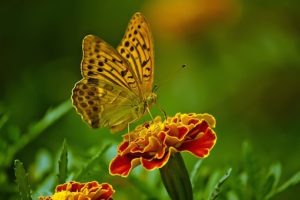
You can make any formal or informal wildlife container garden but it will still need to conform to a tightly controlled design that must benefit the insects that visit your garden. The insects must benefit as much as you do, otherwise, you will not attract them to your container garden.
The container garden must be inviting, so you need to create habitats for nesting insects, whilst providing food for them. Plant rich in pollen and nectar will ensure that there is a reason to visit your garden, and as a result, you will see many kinds of bees, wasps, butterflies, and hoverflies flying around these plants.
There are not only important pollinators, as some of them are effective pest controllers. Wasps and Hoverflies are very important in this regard as they can control, aphid infestations in your container garden.
VITAL ROLE BEES AND WASPS PLAY
All types of bees feed on nectar and pollen where they forage amongst the flowers. Whilst going along their business their furry bodies will transfer pollen from one flower to another. This pollination will result in the fertilization where the fruit forms. The fruit will contain the seeds from which the plant can propagate itself.
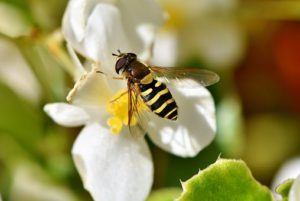
All flowers and fruits need pollinating insects in order to reproduce, without them many native species will simply vanish. Wasps, on the other hand, eat insects as their main form of food, and in the garden, they will feed on aphids and other pests.
TYPES OF INSECTS
There are three main types of bee found in gardens in the UK. These include:
Honeybee
These bees are what beekeepers keep as they are the big honey produces. They are a hierarchy in bees, where the queen lays the eggs, the male drones who never leave the nest (their job is to protect the hive) and female worker who does all the collecting of pollen and nectar. Surprisingly at times, they will collect water to bring back to the hive.
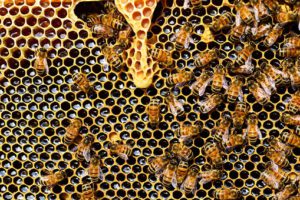
Nectar collected is turned into honey, which is their main food daily and stored in combs especially for the winter months. Pollen, on the other hand, is honeybees’ source of protein, which is essential for the bees to provide food for the young ones.
Bumblebees
Bumblebees are easily recognized as the round shape with black, white and yellow markings are unmissable. The queens are large where in early spring she can be seen flying around looking for suitable nest sites. They will use anything that they can find from mouse nest, birds nesting boxes or even a compost heap.
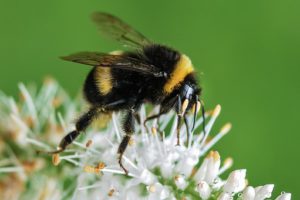
The queen will start to build the nest on her own, where the duties are continued by workers as soon as they emerge from the queen. All male and workers die after their work is completed and the Queen has mated.
Bumblebees’ nests are never used again, so if you see a nest in your garden leave them alone if you can. They will not bother you and will be vacated by autumn.
Solitary Bees
There are 200 species of solitary bees in Britain, all living in different places. Some tunnel into sandy soil, whilst others bore into the soft mortar of old houses. Some will use holes that they find and construct cells from mud and pieces of leaves.
The cells are provisioned with enough pollen and a small amount of watered down nectar. An egg is laid into the cells and then it is sealed over. The larvae which hatch only has the food which has provided for, where it eats the pollen, populates and then emerges the following year.
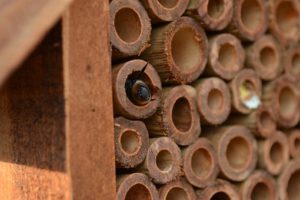
Males emerge first, and then mates with females who appear later on. The males then die after a few weeks after mating. All the cell construction work is carried out by females, where both male and females can be described as looking like a honeybee. The main difference is that solitary bees are better pollinators.
You can attract solitary bees in your container garden by giving them a nesting site. The easiest way to do this is to take a number (15) of 150-200mm long bamboo canes into a bundle, tie them up, and then position them in your garden.
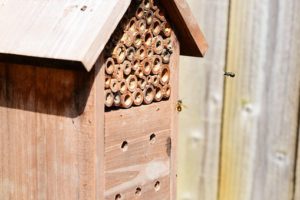
Another possibility is to use a bee post, which is simply made by drilling 4-10mm diameter holes in a thick piece of untreated bombers. Please make sure that all splinters on the edges of holes are removed so not to injure the bees. Fix the post to the edges of a shed or against a fence or stone wall. Make sure that the place is dry and does not get too much moisture.
Wasps
Several species of wasps are found in our gardens, all look similar in appearance, being different only in size and minor changes in colour patterning.
The queen emerges in March/April where it goes looking for suitable nesting sites, where the nests are made of pulp which is produced by the wasps chewing wood fibres. Once the papier mache nest is finished, the queen starts laying eggs in the nest, where the larvae are fed on insects chewed up into a liquid form by the queen. The first workers that emerge take over these duties, except the egg laying, which is the sole duty of the queen. This is why wasp colonies grow very rapidly.

Adult wasps feed on nectar and that is why they visit your garden, to get their sugary treat. They will also catch and kill garden pests to provide protein to the larvae. This means that wasps are actually doing us a beneficial service. Wasps by nature do not store food in their nests, and so large colonies need a large food source. This is why in late summer adult wasps will often go after ripening fruit and beehives, for its honey.
Wasp nest are only used once, so do not see wasps as the enemy but in fact, are providing a service to your container garden.
Hornets
Hornets feed their larvae on other insects and will take and kill honeybees. The British hornet is quite peaceful, where they may be seen in the garden searching for nectar. They will not attack you unless it is provoked.
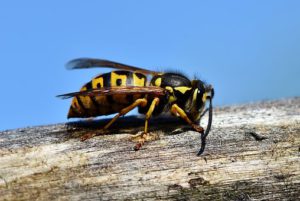
The Asian hornet, on the other hand, is very aggressive. It is a highly effective predator of insects and will hunt honey bees and other beneficial insects. This pest can cause significant losses to bee colonies and other nature species.
Now you know more about bees, it is time to discuss which plants can be grown in your container garden to attract them, along with butterflies, wasps, and Hoverflies.
AGERATINA ALTISSIMA (White Snakeroot)

This clump-forming perennial has oval, pointed, toothed edged green leaves, where from summer to early autumn, upright stems of clusters of tiny, white flowers are produced. The blooms provide a rich source of nectar for bees and butterflies. Plant in a moisture retentive compost in partial shade, where it will grow up to 1.2m in height.
ALCEA ROSEA (Hollyhock)

This short-lived perennial or biennial has rounded, lobed green leaves, from which tall upright stem emerges, growing up to 2m in height. In mid to late summer, these stems bear pink, red, white or yellow cup-shaped flowers. These flowers are loved by bees and butterflies. Grow this plant in a multipurpose compost in full sun.
ALLIUM CERNUUM (Lady’s Leek)

This perennial bulb has strap-like, green leaves that start to fade before slim stalks appear in early summer. On top of the stalks cluster of purple drooping flowers appear that are nectar-rich. These will certainly attract beneficial insects. They prefer to be grown in a multipurpose compost in full sun, where it will grow up to 70cm tall. May require stalking in order to avoid wind damage.
ASCLEPIAS TUBEROSA (Butterfly Weed)

This tap-rooted perennial has masses of oval-shaped, green leaves which on top, vivid orange or yellow flowers are produced in late summer to early autumn. The plant is a magnet for butterflies, where it will grow up to 75cm in height when planted in a well-drained multipurpose compost in full sun. Watch out as the sap is an irritant.
ASTER x FRIKARTII

This 70cm tall bushy, upright perennial has pointed green leaves, where blue flowers with yellow centres appear en masse, through mid-summer to autumn. The nectar-rich flowers provide food for insects when food sources become rarer. Plant this perennial in a multipurpose compost in full sun.
BERGENIA (Elephant’s Ears) ‘Silberlicht’

This clump-forming evergreen perennial has leathery rounded leaves, where in spring reddish stems with clusters of white bell-shaped flowers appear. The flowering buds are a deep red colour and so will contrast very well with the flowers. Grow this 45cm tall perennial in a moisture retentive multipurpose compost in full sun or partial shade.
CALENDULA OFFICINALIS (Pot Marigold)
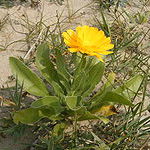
This bushy annual produces masses of orange or yellow daisy-like blooms throughout summer and early autumn.
The flowers are very attractive to insects as long as you choose a single flower variety. Direct sow in early spring in multipurpose compost in full sun or partial shade, where it will grow up to 60cm in height.
CALLUNA VULGARIS (Scotch Heather)

This 60cm tall evergreen shrub has upright stems covered with scale-like, green, gold or silver leaves that change colour in autumn. In late summer to winter, white, pink, red or purple flowers appear that offer some late nectar to insects. Grow this 60cm tall perennial in ericaceous compost in full sun.
CAMPANULA ROTUNDIFOLIA (Common Harebell)

A short 30cm perennial that has small rounded basal leaves, where in summer light blue bell-shaped flowers appear on upright stems. This bee loving plant appreciates being planted in a multipurpose compost in full sin, where no extra fertilizer has been added.
CENTAUREA MONTANA (Perennial Cornflower)

This perennial does best in formal schemes, where branching stems of green leaves and in early summer, thistle-like red-purple centred blue flowers appear. The bees adore these flowers, and if you cut them back after the first flush you will get a second flowering late on the growing season. Grow this 50cm tall perennial in multipurpose compost in full sun or partial shade.
CEPHALARIA GIGANTEA (Giant Scabious)

This 2.5m tall giant perennial looks great in a large container full of multipurpose compost in full sun or partial shade. Will look spectacular as a specimen plant, where in summer pale yellow blooms appear on top of wiry branched stems, above green divided leaves.
CHAMAEMELUM NOBILE (Chamomile)

This aromatic evergreen perennial forms a carpet of feathery green leaves, where white, daisy-like bloom appear on top in late spring to summer. These flowers will be attractive to wildlife. Grow this spreading perennial in a multipurpose compost in full sun, where it will only grow up to 10cm in height.
CLEMATIS MONTANA
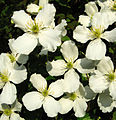
This is a vigorous climbing perennial that grows up to 12m in height, and therefore will need a trellis or being grown against a tall wall. In late spring and early summer, small yellow centred white or pink flowers appear. This will provide a source of nectar food beneficial insects. Grow in a large container full of multipurpose compost in full sun or partial shade.
CROCUS VERNUS

This 12cm tall small perennial bulb, where grassy-green leaves appear first, followed by cup-like lilac or purple flowers in spring or early summer. Plant these corms in groups in multipurpose compost in full sun and will provide some nectar for the early insects.
DAHLIA ‘Bishop of Llandaff’

This perennial grown from tubers planted in spring produces black-purple glossy, divided leaves, which are followed by semi-double red flowers with dark centres. Single and double flowers are important sources of nectar for bees and butterflies. This 1m tall perennial prefers to be grown in a multipurpose compost in full sun.
ERANTHIS HYEMALIS (Winter Aconite)

This clump-forming tuber has lobed, green leaves, where stalkless, cup-shaped yellow flowers with little ruffs appear in late winter to early spring. Grow this 10cm tall perennial with the spring bulbs in a multipurpose compost in partial shade.
ERICA CARNEA (Heather)

This evergreen shrub with needle-like leaves produces tiny, pink or white flowers in early winter to late spring. The flowers are a vital food source for all insects that are early rises from the winter sleep. Grow this 45cm tall shrub in ericaceous compost in full sun.
ERYTHRONIUM (Dog’s Tooth Violet) ‘Pagoda’

This tuberous perennial has mounds of veined mottled leaves, where in spring pale yellow nodding flowers with swept-back petals are borne. This plant with its rich nectar flowers provides food for insects when it is needed. Plant in multipurpose compost in partial shade with other spring bulbs, where it will grow up to 35cm in height.
FRITILLARIA MELEAGRIS (Snake’s Head Fritillary)

A bulbous perennial that has narrow leaves from which short 30cm tall spikes emerge in spring. On top of these spikes nodding bell-shaped flowers that are chequered, red or white appear. Looks great when mixed with other spring bulbs. Grow it in a moisture retentive multipurpose compost in full sun.
GALIUM ODORATUM (Sweet Woodruff)

This slow-spreading carpeting perennial has emerald green leaves that look great if you are after a wild container garden. This 15cm tall perennial blooms in late spring to mid-summer, where white flowers appear when planted in a moisture retentive multipurpose compost in the shade.
GERANIUM MACULATUM (Wild Geranium)
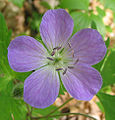
This bushy upright perennial has deeply divided leaves, from which clusters of pale to dark pink or lilac blooms with white centres appear in late spring. This 75cm tall plant is attractive to butterflies when planted in a moisture retentive multipurpose compost in full sun or partial shade. Allow it to neutralize in its growing pot.
GERANIUM PRATENSE (Meadow Geranium)

A clump-forming perennial that has deeply divided lobed, green leaves that turn bronze in autumn and in summer violet-blue sauce shaped flowers appear. Plant this 60cm tall perennial in a multipurpose compost in full sun or partial shade.
HELIANTHUS ANNUUS (Sunflower)
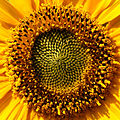
This child’s favourite annual bears large daisy-like, yellow, orange, mahogany or cream flowers with large dark centres throughout the summer months. This plant will attract pollinators, whilst the seed heads will provide food for the birds in autumn. Grow this up to 3m tall annual in a large container full of multipurpose compost in full sun.
HYACINTHOIDES NON-SCRIPTA (English Bluebells)

This prolific naturalizing bulb has narrow strap-shaped leaves, where from fragrant blue bell-shaped blooms emerges that hang down from arching stems. This provides nectar for bees and butterflies in spring. Plant these40cm tall bulbs in multipurpose compost in partial shade in large number in a large container.
KNAUTIA MACEDONICA (Macedonian Scabious)

This tall perennial has lobed basal leaves from which in summer, a succession of crimson button –like flowers appear. Combine this 75cm tall plant with ornamental grasses for a meadow effect. Grow this bee and butterfly attractor in a multipurpose compost in full sun.
LAVANDULA AUGUSTIFOLIA (Lavender)

This evergreen shrub with linear silvery-grey leaves that are aromatic produces a profusion of scented, small purple-violet blooms in summer. These blooms prove to be a magnet for bees, who will flock to them en masse. Grow this 80cm tall shrub in gritty multipurpose compost in full sun.
LIMNATHES DOUGLASII (Poach Egg Flower)

This short annual, only growing up to 15cm in height, has a spreading habit. It has fern-like foliage, where from summer to autumn, rounded, yellow and white flowers appear. The flowers attract hoverflies when planted in a multipurpose compost in full sun.
LINARIA ALPINA (Alpine Toadflax)
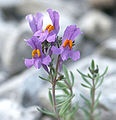
This short-lived perennial has trailing stems, where snapdragon-like flowers of purple-violet orange centres are produced in summer. Allow it to trail over pot edges, where it will grow to 15cm in height when planting this bee attractor in multipurpose compost in full sun.
MAIANTHEMUM RACEMOSUM (False Spikenard)

This 90cm tall perennial has prominently veined oval, green leaves from which flurry, white plumes are produced in mid to late spring. The flowers are sometimes followed by red berries. This perennial is happiest in the shade, so plant it in a multipurpose compost under those conditions. It will need staking and protection from strong winds.
MECONOPSIS CAMBRICA (Welsh Poppy)

This prolific self-seeding perennial has light green, divided leaves, which from yellow or orange poppy-like blooms appear. These are borne on slim stems from late to early summer. The flowers attract bees like crazy when planted in a moisture retentive multipurpose compost in full sun or partial shade, where it will grow up to 45cm in height.
MONARDA (Bergamot) ‘Cambridge Scarlet’

This clump-forming, upright perennial has aromatic, dark green leaves, where whorls or trumpet-shaped red blooms appear in summers. These attractive blooms also attract insect pollinators. Leave the spent blooms as a point of interesting in autumn and to provide an inhabitant for insects. This 1m tall perennial will do well when grown in a moisture retentive multipurpose compost in full sun or partial shade.
MONARDA FISTULOSA (Wild Bergamot)
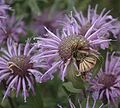
A clump-forming perennial, with whorled heads of small, two-lipped pale lilac bloom on tall stems appear in mid-summer. Grow this bee and butterfly friendly plant in a large container full of moisture retentive multipurpose compost in full sun or partial shade, where it will grow up to 1.2m in height,
MUSCARI ARMENIACUM (Grape Hyacinth)

This familiar spring flowering bulb has narrow green grass-like leaves, where clusters of small deeply blue bell-shaped flowers appear that are fragrant. The bees and butterfly love this 20cm tall bulb when placed in a large number in a multipurpose compost in full sun or partial shade.
NECTAROSCORDUM SICULUM (Honey Garlic)

Such an odd common name for such a beautiful bulb. It is a tall upright bulb which can grow up to 1.2m in height when planted in a multipurpose compost in full sun or partial shade. The bulb produces narrow green leaves that fade away as a tall stem is produced that have clusters of pendant, bell-shaped cream- white with purple stripes on top of the stems. The flowers emerge in early summer that is followed by attractive seed head. Grow this bee friendly plant in a multipurpose compost in full sun or partial shade.
NEPETA x FAASSENII (Catmint)

This 45cm relatively short bushy perennial has small grey-green aromatic leaves from which spikes of lilac-purple flowers appear from summer to autumn. The plant will not only attract cats but will also attract bees and butterflies to your container garden. Plant this perennial in full sun in a multipurpose compost. Repeat flowering is possible if it is cut back immediately after blooming, where a second flush can emerge later on during the growing season.
PAPAVER RHOEAS (Field Poppy)

This annual wildlife favourite has divided green leaves and in summer bowl-shaped, scarlet flowers with black centres appear. Sow the seeds directly in multipurpose compost in full sun in spring or in autumn, where they will grow up to 60cm in height, Turn the compost over after the plant has died back, at least one time a year, as this will encourage repeat germination the following year.
PRIMULA VERIS (Cowslip)
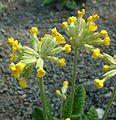
This semi-evergreen perennial forms rosettes of corrugated green, oval lance-shaped leaves. In spring tight clusters of very fragrant, nodding, tubular pale yellow flowers appear on thick stems. The flowers will attract the bees and butterflies when grown in a moisture retentive multipurpose compost in full or partial shade.
PULMONARIA AUGUSTIFOLIA

This 23cm tall perennial forms a low clump of matt, mid-green leaves that is fast spreading. In spring, blue trumpet-shaped blooms appear that will provide nectar for the early insects. Plant it in a moisture retentive compost in full sun or partial shade,
Remove the spent grown in summer as this is when the plant tends to die back.
SCABIOSA ATROPURPUREA (Pincushion Flowers)
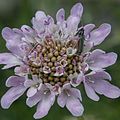
This perennial, often grown as an annual, is clump forming. It has narrow toothed green leaves, which from small, domed heads of purple flowers with cream antlers appear in summer. Grow this bee and butterfly attractor in a multipurpose compost in a sunny location, where it will grow up to 1m tall.
SCABIOSA LUCIDA (Glossy Scabious)

This short perennial only grows up to 20cm in height but it is neat and compact. It bears a basal clump of divided grey-green leaves where blue pincushion-like blooms appear in spring to autumn. Plant this bee and butterfly friendly plant in large groups in a container full of multipurpose compost in full sun.
SCILLA SIBERICA (Siberian Squill)

This perennial bulb has strap-like green leaves, where blue nodding bell-shaped bloom appear. In spring bees are attracted to these blooms, which look at its best when planted with other spring-bloom perennials and bulbs. It grows only to 20cm in height when planted in multipurpose compost in full sun.
SEDUM SPECTABILE (STONECROP)

This fleshy leaf perennial produces large flattened pink flower heads that are attractive to pollinating insects. This 45cm tall perennial prefers to be grown in a multipurpose compost in full sun. Leave the flower heads over winter to provide interest during the cold season.
SELINUM WALLICHIANUM (Wallich Milk Parsley)

A tall upright perennial that grows up to 1.2m in height, has flesh-like leaves. From these heads of starry, white flowers appear in summer, which is attractive to hoverflies. Use this plant if you want a meadow effect when planted in a multipurpose compost in full sun.
SILENE DIOICA (Red Campion)

A semi-evergreen perennial that tends to form into clumps, where small vivid rose-pink flowers that appear from late spring to mid-summer. This moth and butterfly attracting plant can be grown in multipurpose compost in partial shade, where it will grow up to 80cm tall.
TAGETES PATULA (French Marigold)

This familiar annual are often grown for their flowers that came in shades of yellow, orange, red or mahogany. The flowers appear from summer to autumn, over deeply divide aromatic, dark green leaves. This 30cm tall perennial will attract hoverflies and butterflies if you choose the single or semi-double varieties. Grow it in a multipurpose compost in full sun.
TELLIMA GRANDIFLORIA (Fringe Cups)

This is a semi-evergreen perennial that has bright green with a tinge of purple, heart-shaped leaves. In late spring to midsummer 65cm tall spikes of small creamy- yellow bell-shaped flowers appear. The flowers provide nectar for insects when grown in a moisture retentive multipurpose compost in the partial shade.
THALICTRUM AQUILEGIIFOLIUM (Meadow Rue)

This tall perennial grows up to 1.2m in height, where clusters of fluffy, lilac purple summer flowers appear. This is followed by attractive seed heads, all above finely divided grey-green leaves. Grow this perennial in a large container full of multipurpose compost in partial shade, where it will attract beneficial insects.
VERBENA BONARIENSIS (Purpletop Vervain)

This is a very tall perennial, growing up to 1.5m in height, where from mid-summer to autumn domed clusters of scented, violet-purple flowers appear that are attractive to bees and butterflies. Grow this versatile plant in a large container full of multipurpose compost in full sun. Watch out as it can self-seed prolifically.
VERBENA HASTATA (American Blue Vervain)

This is yet another tall perennial that has a more bushy habit. It has narrow toothed leaves and a head of violet-blue flowers. Grow this prolific self-seeding perennial in a moisture retentive multipurpose compost in full sun. This plant will attract butterflies from mid-summer to autumn, where it will grow up to 1.5m in height.
CONCLUSIONS
In this article, the container plants that can be grown for attracting beneficial insects have been discussed in great detail. Numerous nectar and pollen-rich plants have been suggested, but this is only scratching the surface, as any short perennial that produces pollen or nectar will appeal to these insects.
If you provide a home for winter, and enough colourful plants in the summer, then you will be attracting bees, wasps, butterflies, and hoverflies to your container garden. If you are daring enough and have the resources, why not think about having a beehive in your garden. This will not only make delicious honey for you but will ensure that your fruit crops are pollinated.
If you have any questions that you wish to make or a comment that you have to make, please make a beeline to the comment box below.
Please do not forget to share this important news with your friends, family, and neighbours. Save the bees and grow an insect-friendly container garden today.
Be Bee Friendly.

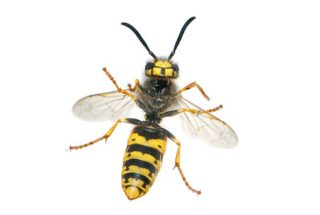
My grandma is tending a garden in our cottage and the other day we were talking about planting some flowers which are going to attract some beneficial insects to it.
She loves chamomile so I think that we are going to go for it. Also, we have immediate access to daisies. Do they have the potential to attract any beneficial insects or we will be wasting our time planting them?
Hi Harry
As long as the plant in question does have plenty of nectar and pollen then they are suitable to be grown in containers. Chamomile is an excellent choice.
Thank you
Antonio
Hello Antonio, this article is very helpful and informative. My wife and I have a garden behind the house and those are primarily container plants. I enjoy when I see those insects coming to the flowers as they are spreading the pollen which is helpful for our planet. You give an idea what else can I grow, thank you for sharing.
Hi Daniel
It is good to help insects as much as possible, and a insect friendly garden must be attract the insects whilst looking appeasing to the eye.
Thank you
Antonio
I think once people realize the services bees and wasps can provide for the sake of their gardens, the more inclined they’ll be to not only leave them and their nests alone, but also to plant some of what you listed to attract them. I knew bees had a significance and if they were to die out, our lives would forever change. It was a shocker to see wasps and hornets’ roles in gardens, and now if someone I know is talking about getting rid of a hornets’ nest, it might not be the best idea.
Hi Todd
It is always amazing want goes in gardens under our noses, we all benefit and should leave insects alone as much as possible. It is good to help need as much as possible, so it is advised to plant as many friendly plants as possible.
Kind regards
Anton up o
Another great post! I always wanted to plant a butterfly weed. But I was advised that I should not mix or put them near my salad plant, is it bad?
I like the idea of creating an ecosystem where butterflies can find a place to come and live. Because, I do visit some garden where I can take pictures, having them in my garden will really mean everything.
Thanks
Hi Adyns
Butterfly weed can cause mold digestion problem if eaten, as long as you do not do this, then I cannot see why it cannot be planted near vegetables. All you need to do is practice common sense.
We all must look after our insect friends, otherwise we will be poorer without them.
Kind regards
Antonio
WOW – I enjoyed reading all of this great information! I have some honey garlic growing in my garden, but never knew what it was called until I read this. Glad to know that it’s beneficial. I was unaware that wasps help to reduce aphids. We have several wasp nests around our property and have always thought they were just pests. I’m very allergic to their stings. We will just leave them alone and let them help the garden now – Thank You!
Hi Betsy
It is amazing what wasps do is our gardens, if people know about their benefits instead of their negatives.
Honey garlic is my favourite as well.
Thanks
Antonio